
My sit spot at my first session.
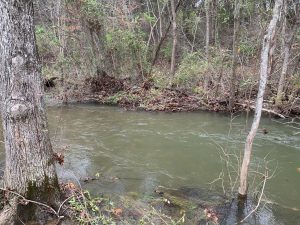
My sit spot at my final session.
It has only been a week since I have last visited my sit spot, but the surrounding environment has still significantly changed; this can predominantly be attributed to the flooding that has occurred in the area due to the extensive rain that has been occurring in the past week. Primarily, several trees in the west bank that sits adjacent to my sit spot have been uprooted due to the influx of water. However this is not the only change exhibited by the trees in the environment; the trees were even barer than they had been in the week prior, and they had lost the majority of their remaining leaves, exposing their branches and bark. Furthermore, much of the greenery that enveloped the forest floor had died in the week that I had been away from my sit spot; the perky, green wild grasses that I had become accustomed to, now laid flat across the forest floor and were a yellow color, indicative of their death. Finally, the various flowers surrounding my sit spot (both Ironweed plants as well as an unknown species of a yellow flowering plant) has also been drastically altered since my prior sit spot. The flooding of the stream had swept away the majority of the flowering plants altogether, and I assumed they had been carried downstream; in fact, only a fifth of the original plants seemed to remain where they had been previously.
Over the course of the semester, my sit spot was altered drastically. Foremost, I watched as the trees changed, mirroring and reflecting the changing seasons; this phenomenon was of special interest to me because it is an occurrence that I rarely get to witness in my home state of Arizona. The trees surrounding my sit spot initially bore vibrant, green leaves in the late summer months; however, as the season shifted to fall, the leaves reflected the various shades of autumn, including hues of red, orange, and yellow. As winter the temperatures began to decline, the trees responded by shedding their remaining leaves, forfeiting their foliage in the face of the winter season. Furthermore, the flowers surrounding my sit spot had also changed substantially. Specifically, the petals of each Ironweed plant, once vibrant shades of purple, had withered over the course of time and turned a rust color. Moreover, the leaves of the various Ironweed plants had also succumbed to death; their structured green leaves had been traded in for wilting brown ones.
When I arrived at my sit spot the weather seemed ominous, and the sky was covered in dark, gray clouds, indicative of a potential coming storm; however, there was no precipitation during my observational period. It was moderately warm when I recorded my observations (I approximated around 60 degrees Fahrenheit), but a prominent chill was carried by the prevalent winds; in fact, the winds were so strong that they carried a tree branch with them which flew closely past my stationary body.
Originally, all I could hear at my sit spot was the howling of the wind and the rustling it caused amongst the tree branches as it ran through them. However, as I focused on my auditory senses, I was able to hear the array of bird calls present in the surrounding area; contrasting pitches and tones flooded my senses, but I was unable to find and observe the organisms emitting these noises. Thus, I searched the canopies of the trees in an attempt to identify these individuals, and I quickly spotted the sizable brown wingspans of what appeared to be several vultures flying in a circular pattern in the sky above; I believed this behavior indicated that the birds had found some organism to prey on. After watching the birds glide in the grey sky, I turned my focus to the forest floor, a location that is usually teeming with animal life; however, even after observing the ground for a lengthy period of time, I witnessed no signs of animal activity. I looked for a possible explanation as to why there were minimal signs of life; I noticed the soil was abnormally damp, and I wondered if the flooding had potentially wiped out some of the insect life. However, after changing locations and retreating to somewhat higher ground, I was met with the black and brown ants that I had observed in my prior sit spots; the ants paced up and down the blades of wild grass that were pressed against the ground, and other than this seemingly random movement, the ants were not engaging in many other behaviors. The final animal I observed was an unknown species of some type of winged insect. Its body consisted of clear wings and a green body that juxtaposed with the white bag it landed on; this six-legged creature was minuscule (smaller than a dime), and it was predominantly stationary until it flew off.
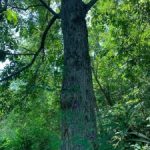
The black walnut tree at my first sit spot session.
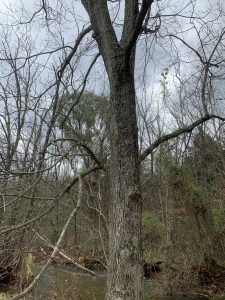
The black walnut tree at my last sit spot session.
Each of the objects I have been following during the duration of this study has also significantly changed. The black walnut tree that towers to the south of my sit spot originally exhibited a display of vibrant green leaves that were burdened with holes from where insects had feasted upon the foliage. However, similar to the other trees that populated
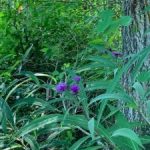
The Ironweed plant at my first sit spot session.

The Ironweed plant at my final sit spot session (most of the plant had been wiped out).
the forest, its leaves mimicked the changing seasons, their colors changing to autumnal pigments. Over time, and as winter approached, these leaves were lost completely, revealing the structural components of the tree. The Ironweed plant I had observed for the duration of the study had also been significantly altered over this period of time. Its petals had changed from a vibrant purple color to a rusty brown, and their volume had also been extensively reduced as they had shriveled. Furthermore, the leaves of these plants, initially structured and a vibrant green had changed so that they were wilted and brown. The stream was a constant in the first month of my observational study, and its waters were typically calm and clear; I was consistently able to see the bed of the stream, enveloped in leaf litter, and I was also occasionally able to catch a glimpse of a fish that had managed to find its way into my line of view. However, after precipitation levels increased in the fall season, the stream reflected this excessive input of water; its currents became stronger and more turbid, as I
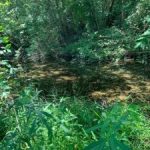
The stream at my first sit spot session.
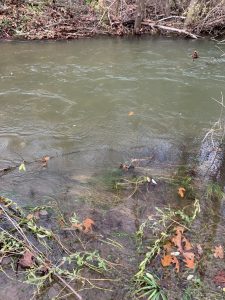
The stream at my last sit spot session.
was unable to see any of the contents contained in the body of water.
My sit spot investigation has been an overall positive experience; apart from the terror, I felt when I had to do my observations at night, I generally enjoyed sitting in nature and becoming familiar with my surroundings. I do feel that I have gained a new perspective from taking part in this investigation, a perspective that allowed me to greater appreciate the benefits that spending time in nature provides. Furthermore, I feel that my sit spot experience taught me about my own personal detachment from my senses. This was evidenced on numerous occasions, including the following experiences: when it took me a lengthy period of time to notice an entire deer standing in front of me, when I repeatedly could not smell anything in my surroundings, and when I didn’t even think to use my sense of touch in making observations. Over time, I would say that my sit spot observations have made me more comfortable in nature, as I have grown to understand and appreciate the role that each organism plays within a given ecosystem. In fact, a clump of spiders fell on my lab notebook at my previous sit spot session, and I didn’t even scream which I would deem a major improvement in my comfortability in nature. Furthermore, the investigation did make me want to spend more time in nature as I have found it to be a peaceful and quiet place that I can use for thoughtful reflection.
The coolest thing I have experienced at my sit spot was witnessing the change in the habitat directly after it had been flooded; the ability to note the differences in an environment before and after a natural disaster was something that I found to be extremely interesting. Perhaps I found this phenomenon to be enticing because I seldom see this kind of flooding in Arizona, but I think the flooding was engrossing because it highlighted the sheer destruction that water, a nutrient so often desired by plant life, could entail.

Leave A Comment
You must be logged in to post a comment.